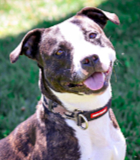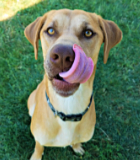Teaching Your Dog to Play Hide-and-Seek
- This topic has 0 replies, 1 voice, and was last updated 14 years, 11 months ago by
Mackenzie’s Admin.
-
AuthorPosts
-
June 17, 2010 at 5:28 pm #545
Mackenzie’s Admin
MemberPlaying interactive games is a lot of fun for both dogs and their pet parents. But it serves some practical purposes, too. Structured games can give your dog a great mental and physical workout, teach her useful new skills, and strengthen your relationship with her. Hide-and-seek, for example, can enhance your dog’s problem-solving abilities, deepen her appreciation of your presence while teaching her not to panic when you disappear, and help her learn to come when called. This game will also give her a chance to use her powerful nose, which is satisfying and tiring.
Getting Started
It’s easy to train your dog to hunt for you when you’re hidden. The key is to teach her how rewarding it is to find you.How to Play
First, get some tasty treats or your dog’s favorite toy.
Ask your dog to sit-stay or down-stay. If your dog doesn’t know how to stay yet, have a helper hold her collar for you.. (If you’d like to teach your dog to stay on her own, please see our article Teaching Your Dog to Stay.)
Go to another room and find a hiding place. Remember to take your dog’s treats or toy with you so that you can reward her immediately when she finds you.
When you’re in your hiding place, call your dog to come to you—just once. (If you have someone helping you, ask them to release your dog’s collar as soon as you call her.) Then wait while she searches.
As soon as your dog finds you, throw a party! Praise her enthusiastically and give her several treats, or toss her favorite toy and play a quick game of tug or fetch if she enjoys these games. (Please see our articles, Teaching Your Dog to Play Tug-of-War and Teaching Your Dog to Play Fetch, for information about these games.)
When you introduce hide-and-seek, choose hiding spots that will allow your dog to find you easily. If you make it too hard in the beginning, your dog might give up! At first, try hiding just out of your dog’s sight. Have her stay or ask a helper to hold her in one room, and then hide right around the corner in the adjoining room. You’ll be totally visible when your dog enters the room where you’re “hiding,” so she’ll have immediate success. After a couple of repetitions, hide behind a piece of furniture in the adjoining room instead—but make sure some part of you is still visible.When your dog has successfully found you partially hidden two or three times, you can make the game a little harder by hiding yourself completely so that no part of you is visible when she enters the room. Now your dog will learn to rely on her nose instead of her eyes. This skill comes naturally to dogs, but some never learn to use it. Your dog will discover that it’s actually easier for her to sniff you out than it is to search for you visually. She’ll have a fantastic time trying to find you and, if you play hide-and-seek regularly, she’ll learn to love coming when called because she’ll associate it with lots of fun.
Troubleshooting
Before your dog understands how to play hide-and-seek, she might get distracted by something else instead of coming to find you when you call her. To build her interest in the game, make finding you a big event for your dog. Reward her with bits of chicken, hot dog or cheese, a new chew bone or a new toy. When your dog discovers that it really pays off to play, she’ll be hooked on hide-and-seek in no time.Be sure to regularly practice basic stays with your dog, returning to her to release her from her stay. If you always call her from the stay, she’ll start to anticipate and break her stays and you’ll have to re-train her to stay. Alternatively, you could use the cue “wait” for hide-and-seek instead. Wait means not to move forward from a given spot or threshold but doesn’t require a particular position like sit or down.
Advanced Hide-and-Seek
As your dog becomes better at finding you, you can hide in more difficult places, like in different rooms of your house, underneath furniture or blankets and in closets. Be creative! You can also move the game outside. If you have a fenced backyard, try playing hide-and-seek there. When you ask your dog to stay or have someone hold her, position her behind a large object or barrier so that she can’t see where you go to hide.After your dog has practiced finding you in your own yard for a couple of weeks, you’re ready to play the game somewhere else—as long as the area is safely fenced. If you have trouble finding fenced areas, you can modify the game to make it safer. Just attach a 15- to 30-foot leash or lightweight rope to your dog’s collar. After you’ve hidden and called her to come find you, a helper can hold the end of the leash or rope and follow your dog while she searches for you.
More Fun Things to Do
Because boredom and excess energy are two common reasons for behavior problems in dogs, it’s important to explore a number of different ways to keep your dog’s brain and body busy. Playing interactive games like hide-and-seek will go a long way toward keeping your dog happy and out of trouble. To learn about other fun, practical ways to enrich your dog’s life, both when you’re around and when you’re not, please see our articles Enriching Your Dog’s Life and Exercise for Dogs. -
AuthorPosts
- You must be logged in to reply to this topic.











































